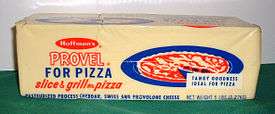Cheese analogue


Cheese analogues (more widely known as cheese alternatives) are products used as culinary replacements for cheese. These include vegan cheeses as well as some dairy products, such as processed cheese or Kraft Singles, that do not qualify as true cheeses. These foods may be intended as replacements for cheese, as with vegan products, or as imitations, as in the case of products used for salad bars and pizza-making, which are generally intended to be mistaken for real cheese, but have properties such as different melting points or lower costs that make them attractive to businesses.
Vegan cheese
As with plant milk, vegan cheese may be made from soybeans, rice, almonds, nutritional yeast and other non-dairy ingredients.[1] It is aimed at vegans and others wanting to avoid animal products, for moral, religious or health reasons, including lactose intolerance or a desire to avoid cholesterol. Vegan cheeses may be lower in fat compared to dairy cheese, are cholesterol-free and are often a source of soy protein and isoflavones. Many have calcium added.[2] Several brands melt similarly to dairy cheese, while others stay mostly firm, or melt only when grated. Varieties include:
Analogue pizza cheese

One variant of pasteurized processed cheese dairy products is designed to melt well on pizza,[25] while remaining chewy. These types of cheeses are sometimes referred to as "analogue pizza cheese".[26][27][28] They are used on some commercially produced pizzas in North America. These types of cheeses may be formulated for processing with basic cheese-making equipment but without the additional equipment and processing that Mozzarella cheese requires, such as the processes of mixing and molding.[29] They tend to have a soft texture and once melted, may have a slightly "stringy" quality when pulled or bitten into. They may lack in a fusion, or melt together when cooked.[26] It has been stated that pizza cheese appears to be the leading type of cheese analogue produced globally.[30] In 1987 it was asserted that—at that time—each year in the United States over 700 million frozen pizzas were sold, three quarters of which contain cheese substitutes.[31]
See also
References
- ↑ Shurtleff, William; Aoyagi, Akiko. History of Cheese, Cream Cheese and Sour Cream Alternatives (with or without Soy) (1896-2013), Lafayette, California, 2013.
- ↑ Soy Cheese - US Soyfoods Directory
- ↑ Tofutti American soy cheese slices Archived January 21, 2009, at the Wayback Machine.
- ↑ Galaxy Nutritional Foods American flavor from rice Archived January 29, 2009, at the Wayback Machine.
- ↑ Blue Sheese
- ↑ Medium Cheddar
- ↑ Vegan gourmet cheddar Archived February 4, 2009, at the Wayback Machine.
- ↑ Galaxy Nutritional Foods Cheddar flavor from rice Archived January 29, 2009, at the Wayback Machine.
- ↑ Cheezly from The Redwood Company
- ↑ Cheshire Sheese
- ↑ Dr Cow cashew nut cream cheese Archived February 5, 2009, at the Wayback Machine.
- ↑ Tofutti Better Than Cream Cheese Archived January 19, 2009, at the Wayback Machine.
- ↑ Edam Sheese
- ↑ Vromages by VegNature Nancy Grenier
- ↑ Gouda Sheese
- ↑ Vegan Monterey Jack Archived March 16, 2008, at the Wayback Machine.
- ↑ Galaxy Nutritional Foods Pepper Jack flavor from rice Archived January 29, 2009, at the Wayback Machine.
- ↑ Mozzarella Sheese
- ↑ Mozzarella soy cheese slices Archived March 12, 2009, at the Wayback Machine.
- ↑ Vegan mozzarella Archived February 4, 2009, at the Wayback Machine.
- ↑ Parma Zaan Sprinkles, almond based, by Vegetarian Express Archived February 14, 2009, at the Wayback Machine.
- ↑ Parmesan flavor rice product Archived January 15, 2009, at the Wayback Machine.
- ↑ Parma Raw Parmesan Cheese Alternative - Walnut based
- ↑ Rice-based Swiss cheese by Galaxy Nutritional Foods Archived January 15, 2009, at the Wayback Machine.
- ↑ Hayes, David K.; Miller, Allisha (2011). Revenue Management for the Hospitality Industry. John Wiley & Sons, Inc. p. 60. ISBN 9780470393086. Retrieved September 29, 2012.
- 1 2 Law, Barry A; Tamime, A.Y., eds. (2010). Technology of Cheesemaking. Wiley-Blackwell. pp. (unlisted). ISBN 9781444323757. Retrieved September 30, 2012.
- ↑ Fox, Patrick F.; (et al.) (2000). Fundamentals of Cheese Science. Aspen Pub. p. 462. ISBN 0834212609.
- ↑ Gunstone, F.D.; (et al.) (2006). Modifying lipids for use in food. Woodhead. p. 476. ISBN 1855739712. Retrieved September 30, 2012.
- ↑ Gunasekaran, Sundaram; Mehmet Ak, M. (2003). Cheese Rheology and Texture. CRC Press. p. 288. ISBN 1587160218. Retrieved September 30, 2012.
- ↑ Law, Barry A; Tamime, A.Y., eds. (2010). Technology of Cheesemaking. Wiley-Blackwell. pp. (unlisted). ISBN 9781444323757. Retrieved September 30, 2012.
- ↑ "Star Tribune Archives". Nl.newsbank.com. 1987-09-11. Retrieved 2012-09-28.
About three-fourths of the 700 million frozen pizzas sold each year in the United States contain cheese substitutes. The most common is casein,...
(subscription required)
